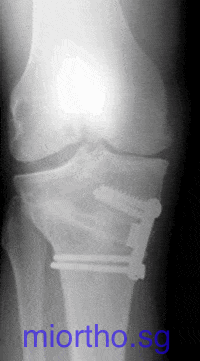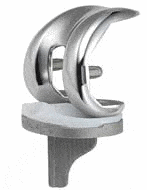Knee arthroscopy ("keyhole" or "scope" surgery)
Patients may complain of very sudden severe painful catching in the knee, or may describe a feeling of something "getting caught in the wrong place" in their knee. These symptoms may occur during walking, or may even occur during simple activities like turning in bed. When these sudden "locking" or "catching" symptoms occur frequently, they may be due to loose pieces of cartilage or bone. These patients may benefit from having these loose pieces of cartilage or bone removed with knee arthroscopy. The sudden painful episodes get better, but patients will continue to have the aching pain of arthritis.
Patients who have a dull ache on standing or walking for long periods, typically do not gain a long-term benefit from arthoscopy to "clean up their joints". As such, knee arthroscopy in this group of patients is typically not recommended.
Stem cells and cartilage resurfacing
The current scientific evidence on stem cells is that these are useful in younger patients (less than 45-50 yrs ago) who have localised cartilage defects (i.e. cartilage ulcers surrounded by relatively normal cartilage in other parts of the knee). If patients have arthritis affecting most of the surface of the knee - stem cell treatments have not yet been shown to be beneficial in this group of patients.

Re-alignment operations or "osteotomy"
As the cartilage wears out, the knee may start to angle towards the worn out side. Sometimes patients notice that their legs have become "bow-legged" over a few years. The more angled the knee is, the higher the pressure is felt in the damaged knee. One option is to "break" the bone and re-align the knee straight. This results in the pressure being transferred to the opposite "good" side of the knee, and reducing pain.
The advantage of osteotomy operations is that joint replacement is avoided. This may be necessary in younger patients (<45-50 years). Disadvantages include longer recovery times (waiting for the broken re-aligned bone to heal), possible non-union or implant failure at the osteotomy site, and the need to be on crutches for up to 2-3 months. Furthermore, the pain relief is not 100% as there is still damaged cartilage present. About 40% of osteotomy patients still require a knee replacement within 10 years of their osteotomy operation.
Joint replacement
Knee joint replacements have been used regularly for knee arthritis since the 1970s. The surgery involves removing the damaged joint and bone surfaces, and replacing them with metallic joints, usually with a piece of polymer plastic in between.
Advantages of knee replacements include the ability to walk with full weight on the knee almost immediately (on the second day after surgery). The operation usually requires about 4 to 6 days hospital stay. Pain relief is reliable in over 90% of patients, and the need of re-operation in the first 10 years is usually less than 5%. 80-85% of patients do not even need a second surgery after 20 years.
Click here to learn more about knee joint replacement for degenerative arthritis.
Back to main patient information.

